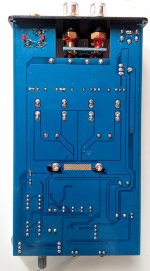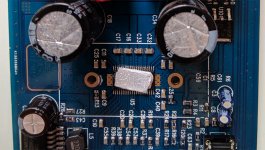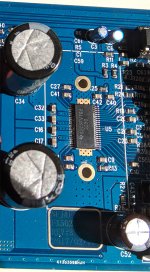The purple thing is NOT the heatsink. Browse Ebay for a silicon pad to put under tpa3250/pcb between pcb and aluminium enclosure, then the enclosure becomes extension of the pcb=heatsink.
I think the aluminium distance to chippins/pcb traces influenced distortion, but browse doctormords website or posts here, must be somewhere if I can remember it 🙂
I think the aluminium distance to chippins/pcb traces influenced distortion, but browse doctormords website or posts here, must be somewhere if I can remember it 🙂
The purple thing is NOT the heatsink.
This thing is aluminum, hot and means it removes heat.
So how can this thing be not a heatsink?😀
And capacitors😀Your inductors are hot, so they must be heatsink too.
pump it up...I'll come back with some feedback once he receives the amp! I usally make a copper column(local scrapper usally has copper in 1cm thickness) and jam that between the chip and the lid. I usally use some super glue in a corner or two of the chip, and and thermal paste the rest of the chip's surface. It's also possible to use thermal glue.. The trick is to cut the copper column to perfect length, usally the pcb has 0.5mm give to it. So when i put the lid back on, the column is held in place from the lid pressuring down.. I think its also possible to buy a copper or brass rod on ebay very cheap. This way the heat is transfered to the big aluminium lid and dissipates 🙂 I can run the tpa3116 at almost clipping@24V and the breeze amp only gets lukewarm.
please photos from your cooling mods
thx
chip's top is plastic, isolates heat, chip's bottom is metal, conducts heat. PCB is heatsink for tpa3250, "increase" pcb (include enclosure)
The purple thing is NOT the heatsink. Browse Ebay for a silicon pad to put under tpa3250/pcb between pcb and aluminium enclosure, then the enclosure becomes extension of the pcb=heatsink.
I think the aluminium distance to chippins/pcb traces influenced distortion, but browse doctormords website or posts here, must be somewhere if I can remember it 🙂
AAAAhhh........ now i get the idea...thx
TPA3251 (TPA3255) aka “Model Tiny” in Aluminiumgehause – #360customs
chip's top is plastic, isolates heat, chip's bottom is metal, conducts heat. PCB is heatsink for tpa3250, "increase" pcb (include enclosure)
But how to make heat dissipates more efficient? Install heatsink on the back of the board is not possible. And this thing on top is bad or good, but it dissipates the heat
It doesn't. The pcb does, groundplane under chip that is, does. Couple that to enclosure with computer cpu pad and you improve situation, maybe removing the purple thing improves THD, I don't know, but it has very little function, it is cosmetic.
But how to make heat dissipates more efficient? Install heatsink on the back of the board is not possible. And this thing on top is bad or good, but it dissipates the heat
every electronic components is tested -look at datasheets at 25°C ambient temperature = that means super cooling plates and water colling etc.. to get fine results. = ideal conditions
you will also find some graphs to get some idea how this components "feels" under heat = more distortion, less power cause of the junction temperature of the silicium chip itself....etc...
more heat away from the components you will get as closed to the ideal condistion
so its like you - if its getting really hot - you get nervous and "strange" ...nosiy.... 😀😀😀
It doesn't. The pcb does, groundplane under chip that is, does. Couple that to enclosure with computer cpu pad and you improve situation, maybe removing the purple thing improves THD, I don't know, but it has very little function, it is cosmetic.
never the less i would keep the purple heat sink + the silicon connected on the buttom of the TPA3250
Last edited:
Tpa3250 performance is tested on this evm pcb, with components as in evm bom, no forced cooling but using standoffs and no enclosure 🙂


You'll need to measure distance between pcb and enclosure, select a pad that is thicker but not too much, because you'll have to get pcb in again and too much pressure might cause some of the smd components to crack, you know pop pop pop pop if it is a little capacitor 🙂 Be carefull because finding the cracked one and replacing it is not a nice job, often ends in replacing all the little caps or ordering a new amp 🙂
here is the overview of different housings
1 PDIP is the good old housing - as you have it in the FX502S
2 SOIC is for SMD
3 To99 is the metall round housing - if you want to try this check the internet for a DIP adapter = DIP 8 socket, as you have it in the FX502
chris
Yes, but which housing is for sale on the TI Shop site? I ordered a pair there, but I am not sure if I am going to get the rectangular or the round housing.
If you used a discount code there was a sale, if not it was regular price.Yes, but which housing is for sale on the TI Shop site? I ordered a pair there, but I am not sure if I am going to get the rectangular or the round housing.
Two packages are currently active, smd soic and pdip, nanopb is pdip, maxnopb is smd, but could see that in datasheet.
That means the TO99 metal can is obsolete, out of production, at the moment.
3rd pic ....looks not real TPA3250....or?
They do not use pcb/heatsink very well, but they did use purple heatsink to cool pcb, it just happened to be above chip, by accident, the screws transfer heat to purple sink
One could use screws and metal/aluminium pad to screw (bottomside) to enclosure
One could use screws and metal/aluminium pad to screw (bottomside) to enclosure
Last edited:
- Home
- Amplifiers
- Class D
- TPA3250 somebody is listening?




